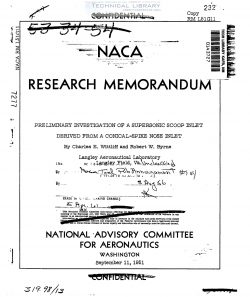naca-rm-l51g11
- Version
- 38 Downloads
- 855.23 KB File Size
- 1 File Count
- May 31, 2017 Create Date
- May 31, 2017 Last Updated
National Advisory Committee for Aeronautics, Research Memorandum - Preliminary Investigation of a Supersonic Scoop Inlet Derived from a Conical Spike Nose Inlet

A preliminary investigation has been conducted on a supersonic
scoop inlet derived from a conical-spike nose inlet at Mach numbers of
1.3, 1.6, and 1.9. Comparison of the pressure-recovery results of the
scoop inlet with results obtained for conical-spike nose inlets shows
that the pressure recoveries were in general agreement for the Mach
number range extending from 1.3 to 1.9. Results of the investigation
show that removal of the boundary layer by means of a sweptback boundaryb
layer suction slot ahead of the inlet was found to increase the pressure
recovery. It was also found that simple elevation (without suction) of
the scoop inlet above the surface on which it was mounted increased the
pressure recovery by roughly two-thirds of the increase obtained when
suction was applied to the same configuration. When the mass flow
through the suction slot was equal to 10 percent of the mass flow through
the inlet with a slot height of 0.058 cowling—lip diameter, pressure
recoveries for Mach numbers of 1.3, 1.6, and 1.9 were 0.93, 0. 9k, and
0.89, respectively, for the 25° half—cone scoop inlet. For this condi-
tion, also, the pressure recovery was found to be approximately constant
with varying inlet mass flows.
The need of placing radar, armament, or other equipment in the nose
of supersonic interceptor aircraft and the desire to eliminate long air
ducts, which would occupy a large volume in an already crowded fuselage,
have been the chief factors in considering scoop-type inlets. Thus, the
need arises for supersonic inlets suitable for installation on the fuse-
lage. One such inlet has been tested at the Gas Dynamics Branch of the
LanglEy Aeronautical Laboratory.
The present inlet consists of a semicircular cowling and a semicone
central body. It is similar to the inlet reported in reference 1
out along a diametral plane. When an inlet is locatedLon the fuse-
lage instead of in the nose of the airplane, the problem of boundary-
layer influence arises. If lowhenergy boundary-layer air were taken
into the inlet; it has been shown in subsonic research that a large loss
in pressure recovery would occur. Therefore, provision for boundary;
layer removal by means of a sweptback suction slot waSTmade on this
inlet.
The purpose of the present research was to obtain a preliminary
determination of the pressure—recovery characteristicsiof this scoop
inlet at various Mach numbers and to evaluate the influence of boundary-
layer removal on the pressure recovery. The test Reynolds number was
also varied over a small range to investigate its effect on the pressure
recovery. The model was designed so that_the height of the boundary—
layer suction slot could be varied, in addition to varying the amount of
suction applied to the slot. The variation of pressure recovery with
entering mass flow was also determined.
| File | Action |
|---|---|
| naca-rm-l51g11 Preliminary Investigation of a Supersonic Scoop Inlet Derived from a Conical Spike Nose Inlet.pdf | Download |

Comment On This Post